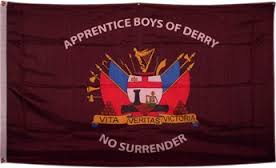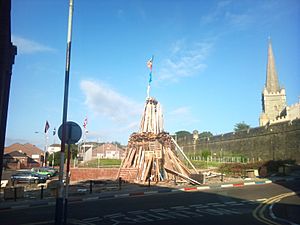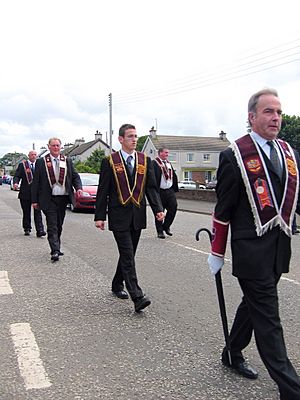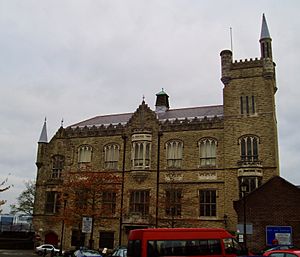Apprentice Boys of Derry facts for kids

Logo of the associated clubs of the Apprentice Boys of Derry
|
|

A flag of the Apprentice Boys
|
|
| Formation | 1814 |
|---|---|
| Founded at | Derry, Ireland |
| Headquarters | Derry |
|
Region
|
Northern Ireland Scotland Republic of Ireland England Canada Australia |
| Subsidiaries | The associated clubs of the Apprentice Boys of Derry |
The Apprentice Boys of Derry is a Protestant group that started in 1814. It is based in the city of Derry, Northern Ireland. In 2021, the group had over 10,000 members around the world. Only Protestant men can join. There are branches in Northern Ireland, Ireland, Scotland, England, Australia, and Canada.
The main goal of the Apprentice Boys is to remember the Siege of Derry from 1689. During this siege, Catholic King James II tried to take over the walled city, which was a Protestant stronghold. In the past, parades by the Apprentice Boys sometimes caused disagreements with the city's Irish nationalist majority. However, in recent years, things have become much calmer, and the parades are now usually peaceful. For example, the 2014 'Shutting of the Gates' parade was very large but had no violence.
Contents
The Great Siege of Derry
The Siege of Derry began in December 1688. Thirteen young apprentice boys famously closed the city gates. They shut out a group of 1,200 soldiers led by Alexander Macdonnell, Earl of Antrim.
Later, the Duke of Tyrconnel gathered a large army to march north. King James II, who had come from France, took charge of this army. On April 18, 1689, he arrived at Derry's gates. The people inside shouted, "No Surrender!" showing they would not give up.
The siege lasted a long time. It finally ended on July 28, 1689. Two merchant ships, the Mountjoy and the Phoenix, sailed up the River Foyle. They broke through a large timber barrier, called a boom, that blocked the river. The ships brought much-needed food and supplies to the starving city. Three days later, the attacking forces left. It is believed that about 4,000 people, half of the city's population, died from hunger or injuries during the siege.
Annual Celebrations
The Apprentice Boys hold two main celebrations each year. The first is the 'closing of the gates' on the first Saturday in December. This remembers the brave actions of the original apprentice boys. The second is the Relief of Derry on the second Saturday in August. This celebrates when the siege was finally lifted.
The Relief Parade in Derry is one of the biggest parades in Northern Ireland. In some parts of the city, people build large bonfires, similar to those seen on July 11. In recent years, the August celebration has grown into the week-long Maiden City Festival. This festival includes many different cultural events. You can find bluegrass music, Irish and Ulster Scots music lessons, and art shows. Other local groups, like the Chinese and Polish communities, also hold events.
During the December celebrations, it is a tradition to burn or hang an effigy (a dummy) of Robert Lundy. Lundy was a governor of Derry who wanted to surrender during the siege.
The Apprentice Boys also work on peace projects. They held an event called the "Derry Maiden Festival" with another group, the Sligo Wild Geese.
In 2007, the Apprentice Boys held 231 parades in Northern Ireland. About half were for the Relief of Derry, and half were for the Closing of the Gates. The main August parade in Derry had around 10,000 marchers and 127 bands.
History of the Clubs
The first celebrations of the relief of Derry happened on July 28, 1689. The people who had survived the siege gathered on the city walls to welcome the ships bringing help. The first organized celebration was a thanksgiving service on August 8, 1689, at St Columb's Cathedral.
On August 1, 1714, a siege hero named Colonel Mitchelburne raised the Crimson Flag on the cathedral. He then formed the first club, known as the Apprentice Boys. The British army in Derry used to organize the August and December events.
In the early 1800s, Catholic citizens sometimes joined the celebrations with their Protestant neighbors. However, by 1869, a government report found that the Apprentice Boys' events were seen differently. Many Catholics then viewed them with "hostile feelings." The report suggested banning both Apprentice Boys and Orange Order parades.
The Apprentice Boys became more important in the early 1800s. The Apprentice Boys of Derry Club started in 1814, and the No Surrender Club in 1824. Over time, eight main clubs were formed: Apprentice Boys, Walker, Mitchelburne, No Surrender, Browning, Baker, Campsie, and Murray. In 1861, these clubs decided to work together under a group called the General Committee. This committee still runs the association today.
The celebrations continue with traditions like firing replica siege cannons and ringing the cathedral bells. Members also raise Crimson Flags and lay wreaths to remember those who died. In December, they still burn an effigy of Robert Lundy.
In 1969, an Apprentice Boys' parade in Derry led to three days of intense unrest. This event is known as the Battle of the Bogside and is seen by some as the start of the Troubles.
Walker's Pillar
Plans for an 81-foot (25-meter) tall memorial to George Walker were finished in 1826. Walker was a Protestant governor during the siege. This pillar became a central part of the celebrations. In 1832, the burning of the Robert Lundy effigy first happened at the pillar.
The pillar was destroyed by a bomb in 1973. Later, the base of the memorial was repaired for the 300th anniversary of the siege. The Apprentice Boys placed the recovered statue of Walker in a new memorial garden. This garden is next to the Apprentice Boys Memorial Hall.
Apprentice Boys Memorial Hall
The Memorial Hall opened in 1877. It was built to honor the thirteen apprentice boys who closed the city gates in 1688. In 1937, the hall was made bigger. This new part remembers those who died in the Great War (1914–1918). The hall is an important building within the walled city.
Today, it is the main office for the Apprentice Boys association. It has offices and a meeting room. All new members are officially welcomed into the group here. Other groups, like the Orange Order, also have rooms in the hall. There is also a social club and a museum. The hall is usually open to visitors during the summer months, from July to September. In 2012, it received money from the European Union to create a new visitors' center.
Membership
New members can only join the Apprentice Boys inside the city walls. Members wear crimson collarettes, which are like collars. These remember the crimson flag that flew from the cathedral during the siege. Only Protestant men can become members.
See also
 In Spanish: Aprendices de Derry para niños
In Spanish: Aprendices de Derry para niños
- Orange Institution
- Royal Black Institution
- Banners in Northern Ireland





